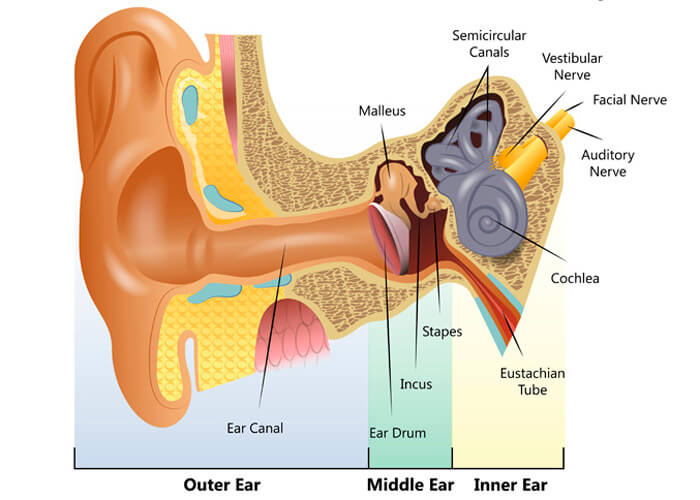There are four types of hearing loss.
- Auditory
- Conductive
- Sensorineural
- Mixed
We’re going to take a look at each type and what it means for a teenager challenged with it. First, we’re going to show you a diagram of the ear to help you visualise where hearing loss takes place.
Image credit: Hearing Link
1. Auditory Hearing Loss
Auditory spectrum disorders occur when there’s a problem with the auditory nerve. Sounds might get transmitted normally though the middle ear and the cochlear, but then does not transmit correctly from the cochlear or auditory nerve. Hence, the message is not transmitted from the cochlear to the brain.
Typically, hearing will be affected between a normal – severe range, and the teenager will have trouble understanding speech clearly. So this teenager might hear other sounds ok, but not hear the spoken word.
2. Conductive Hearing Loss
Conductive hearing loss typically occurs when something in the outer or middle ear is blocking the sound waves to the inner ear.
This type of hearing loss is typically caused by middle ear infections, tumours, perforated eardrums or some kind of trauma to the outer or middle ear.
Typically, hearing is affected and the teenager will have trouble hearing low volume sounds. Hearing aids might help.
3. Sensorineural Hearing Loss
Conductive hearing loss typically occurs when the hairs around the cochlear have been damaged or made deficient.
This type of hearing loss is typically present at birth (ie genetic), or the hairs of the cochlear may get damaged during the teens life span through noise trauma or infection. A common hearing problem with this type of hearing loss is tinnitus.
Typically, this type of hearing loss while being the most common, has assistive technologies like aids, devices and prostheses to help reduce effects of hearing loss.
4. Mixed Hearing Loss
Mixed hearing loss typically occurs there’s a mix of sensorineural and conductive hearing loss.
This type of hearing loss presents itself as permanent for sensorineural and possibly permanent or temporary for conductive hearing loss.
An example of this type of hearing loss is when a teenager with hearing loss from a perforated ear drum also has a middle ear infection.
Teenage Hearing Loss and NDIS
In regards to hearing loss, the NDIS explain “the focus of ‘disability’ is on the reduction or loss of an ability to perform an activity which results from an impairment. The term ‘impairment’ commonly refers to a loss of, or damage to, a physical, sensory or mental function.”
Hear For You is an accredited NDIS provider – offering mentor programs to deaf teenagers; designed to support deaf teenagers, provide guidance and give them the chance to meet some people who actually ‘get’ what they’re going through. If you think you teenager qualifies for NDIS and is interested in one of our programs or workshops, the NDIS might cover some of the expenses. Please contact us today for more information.




